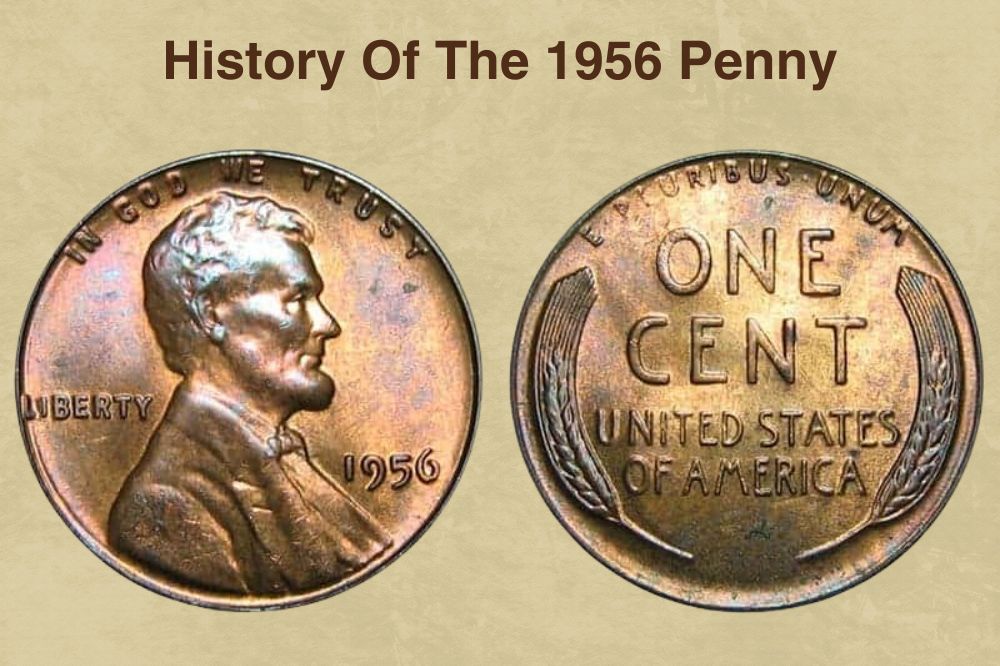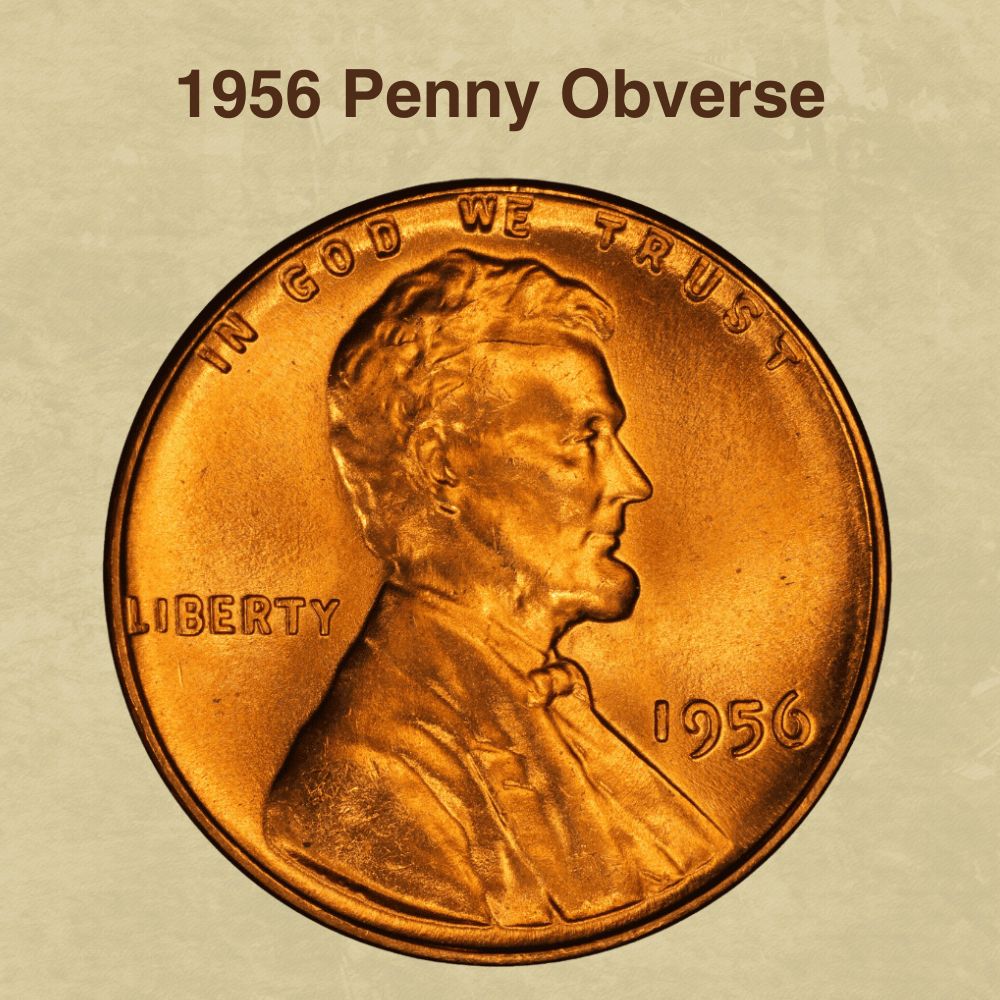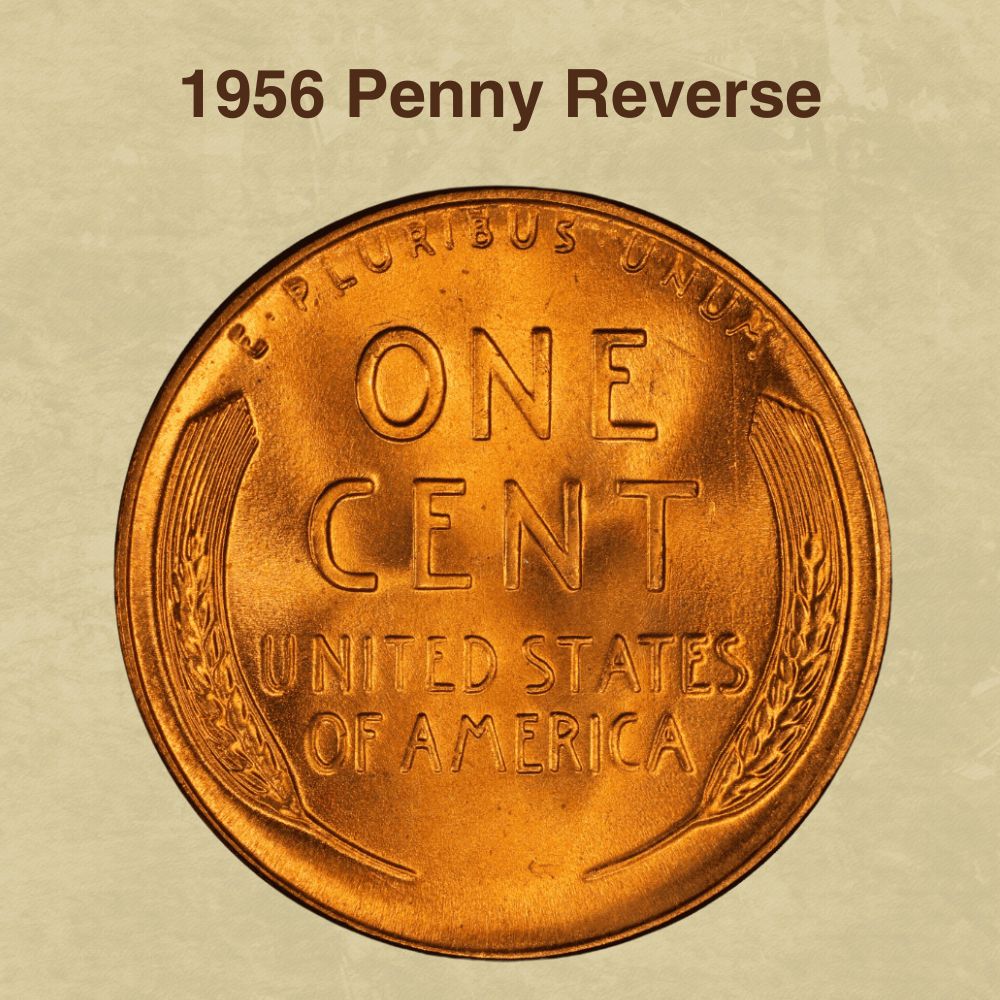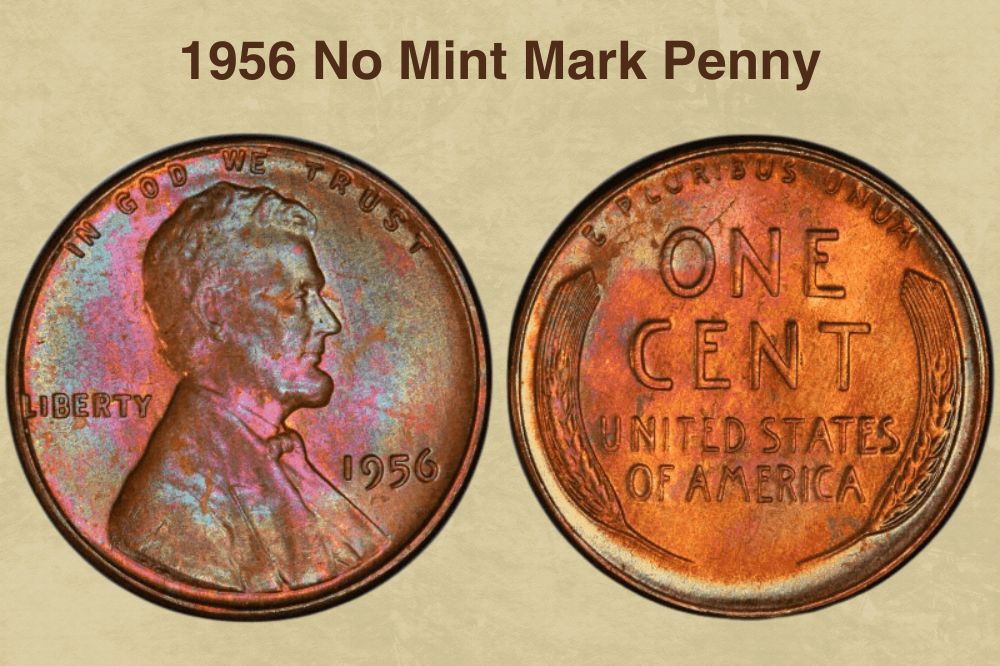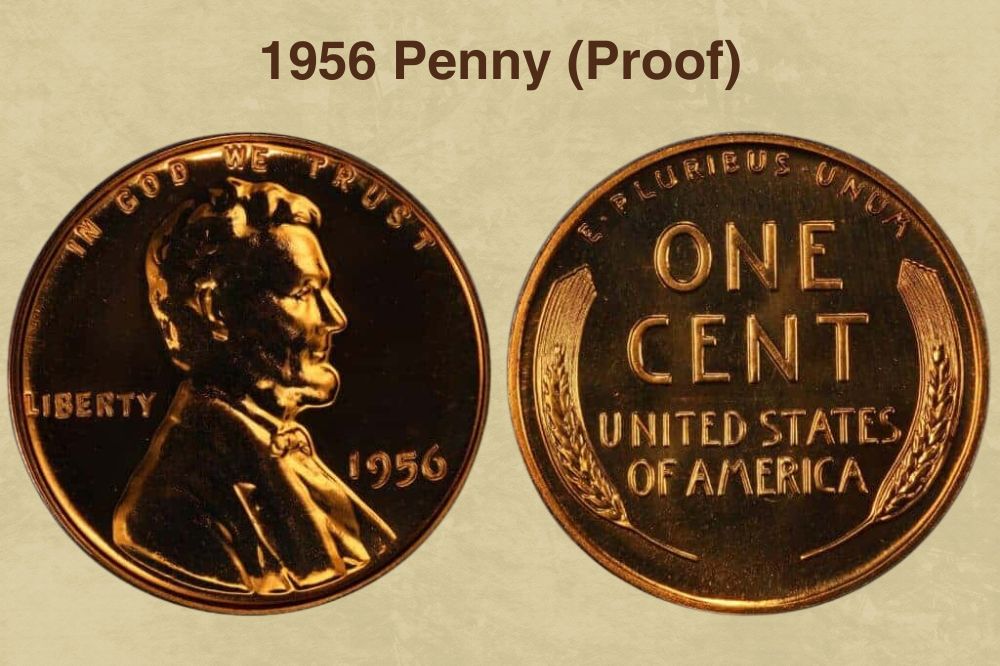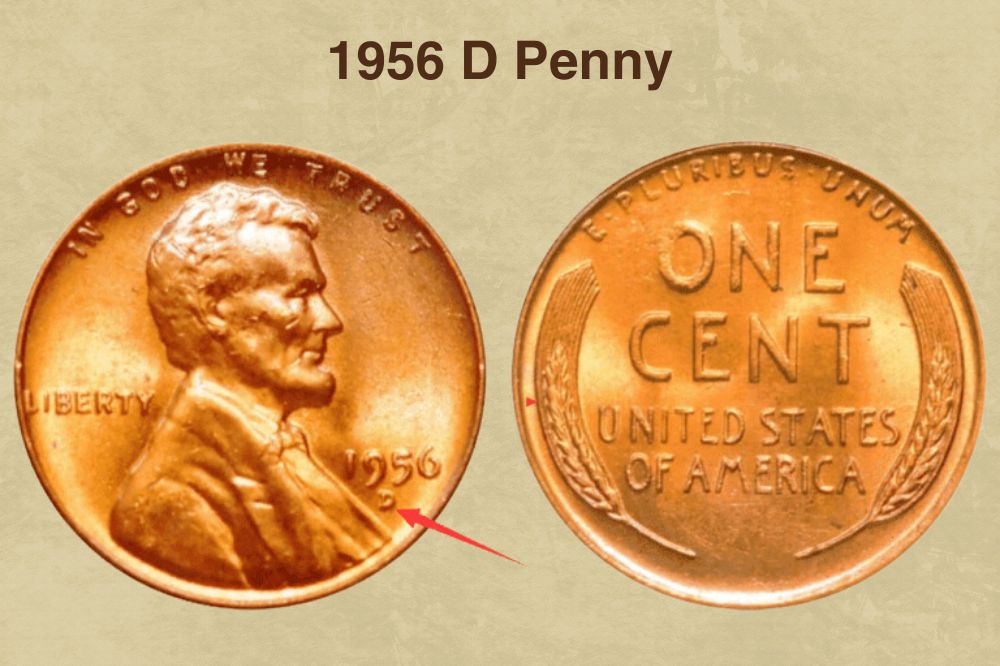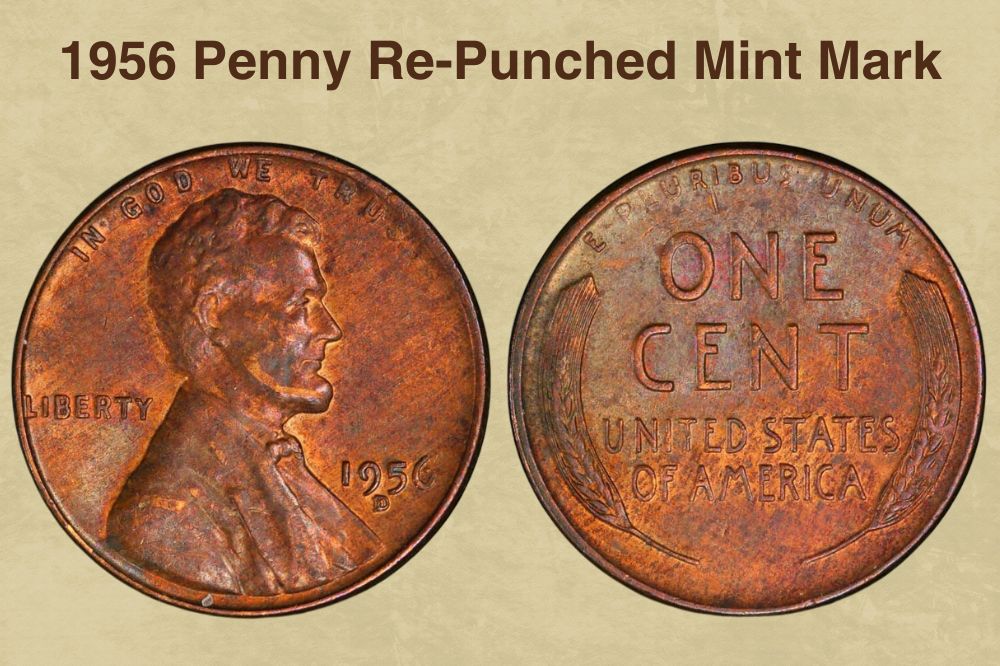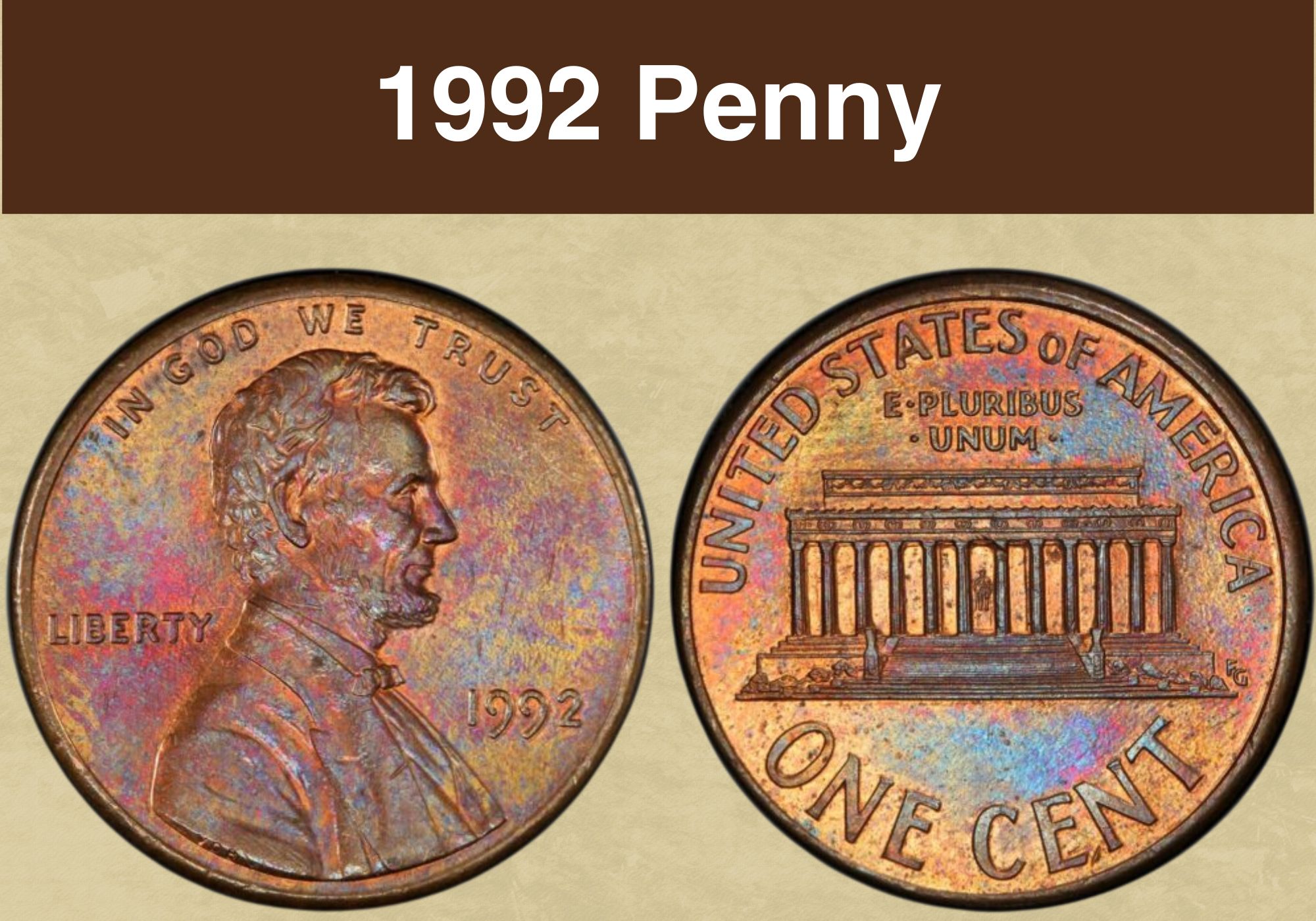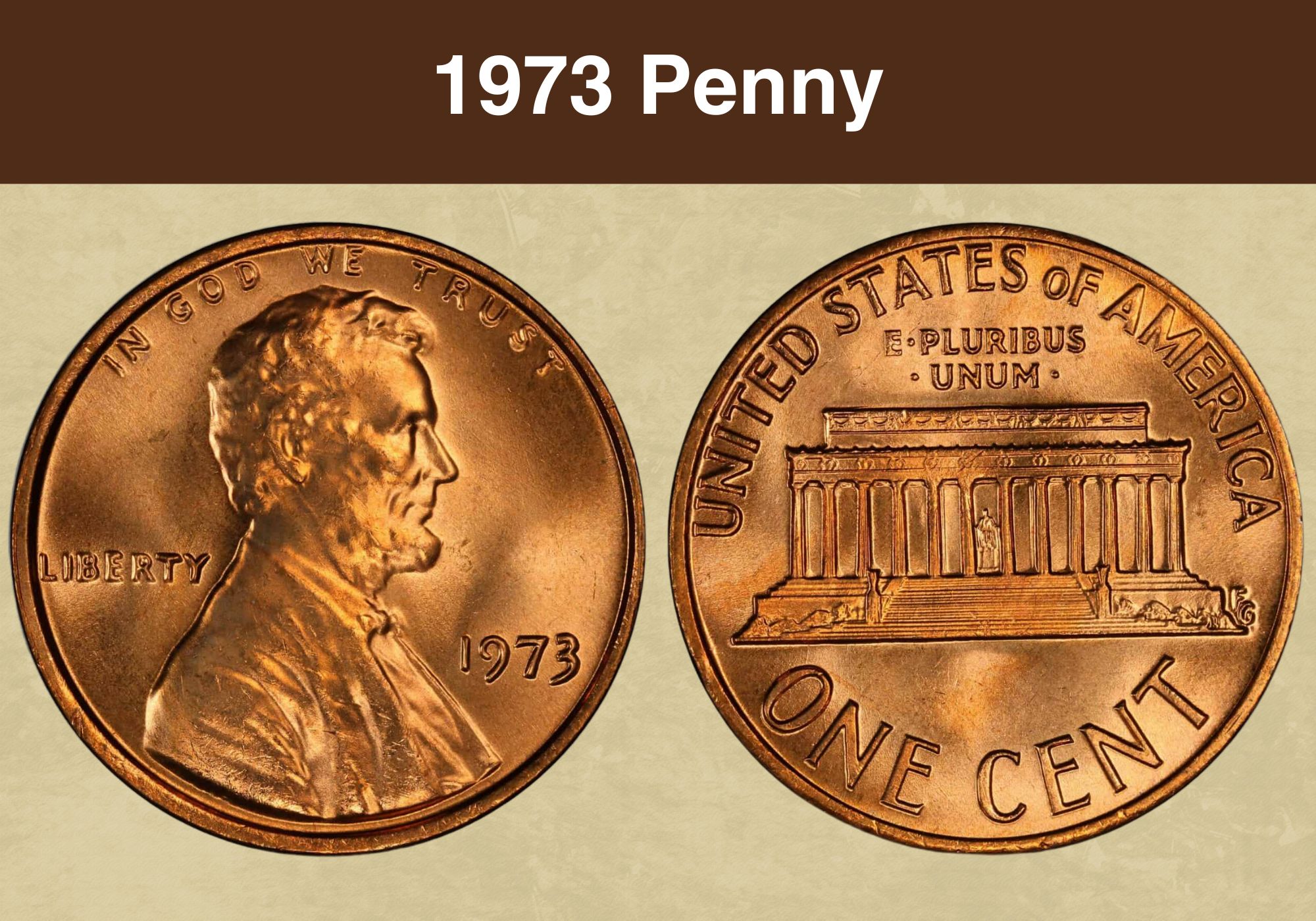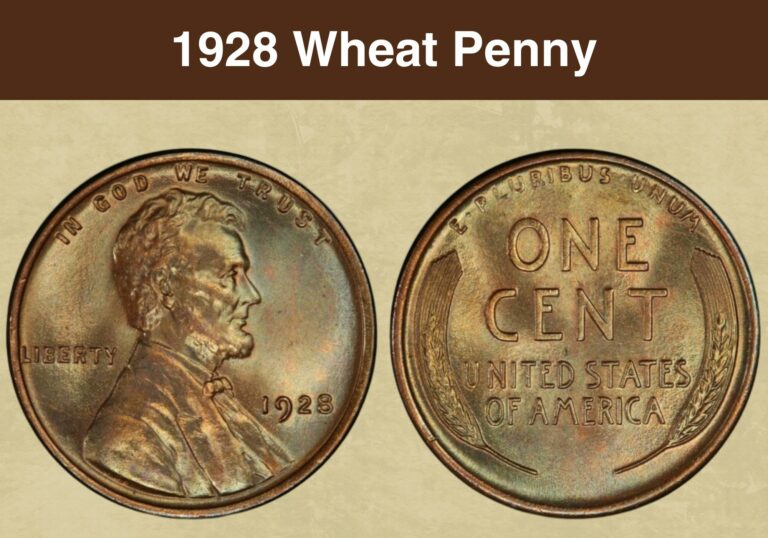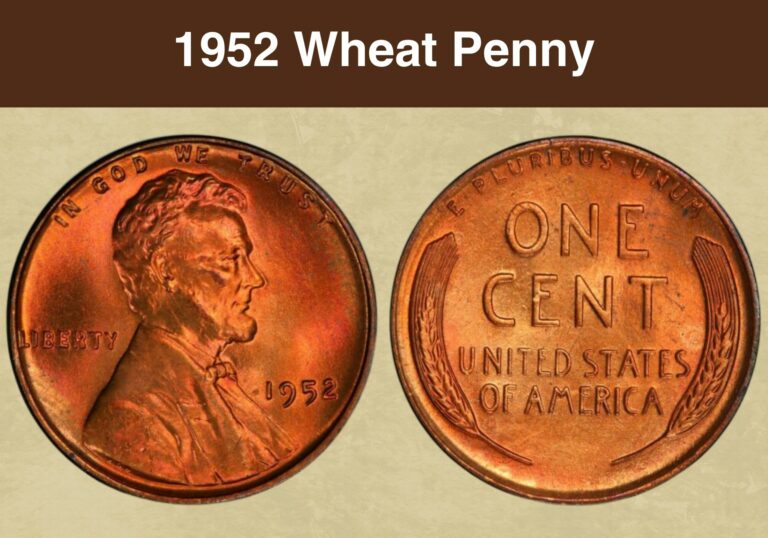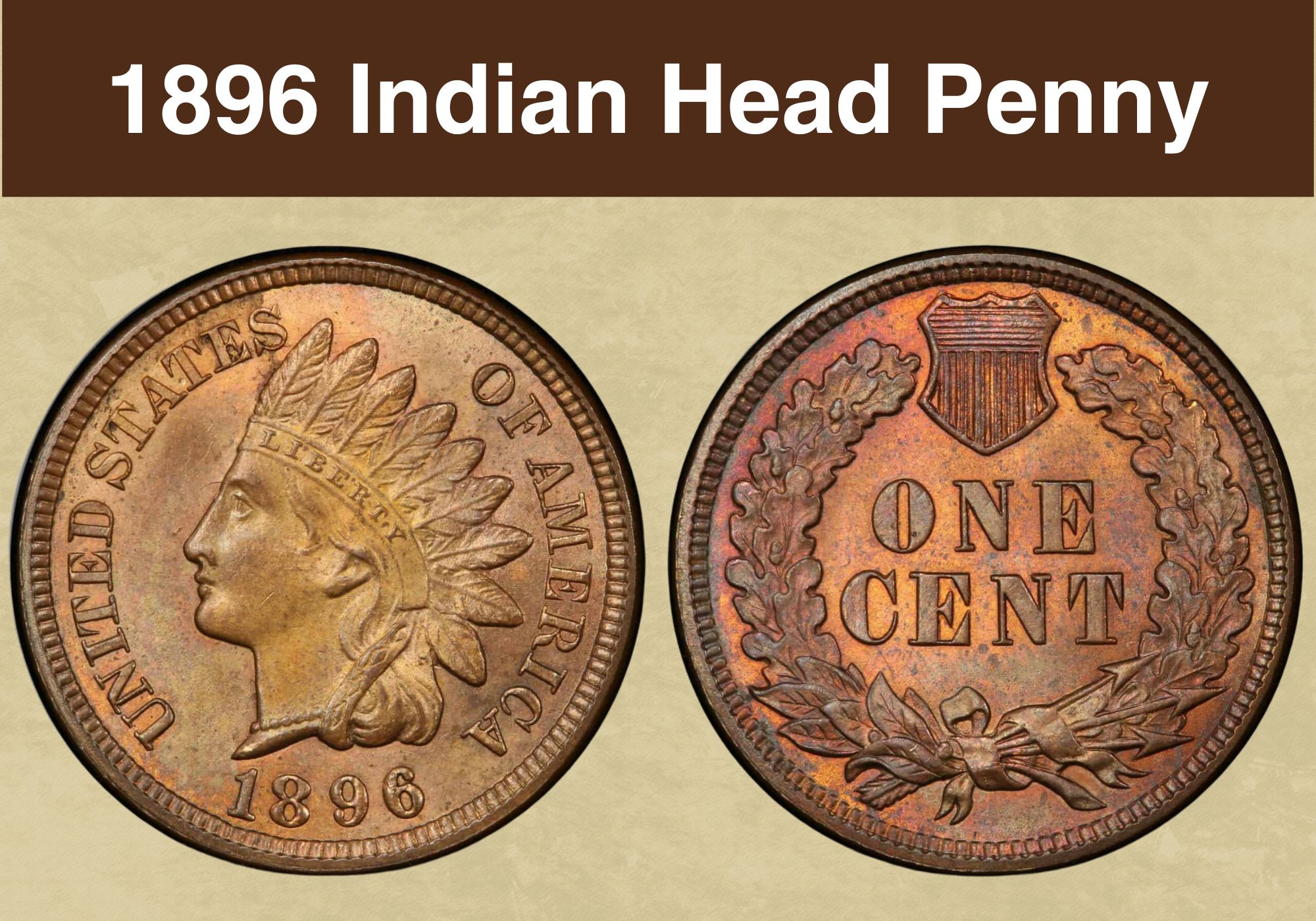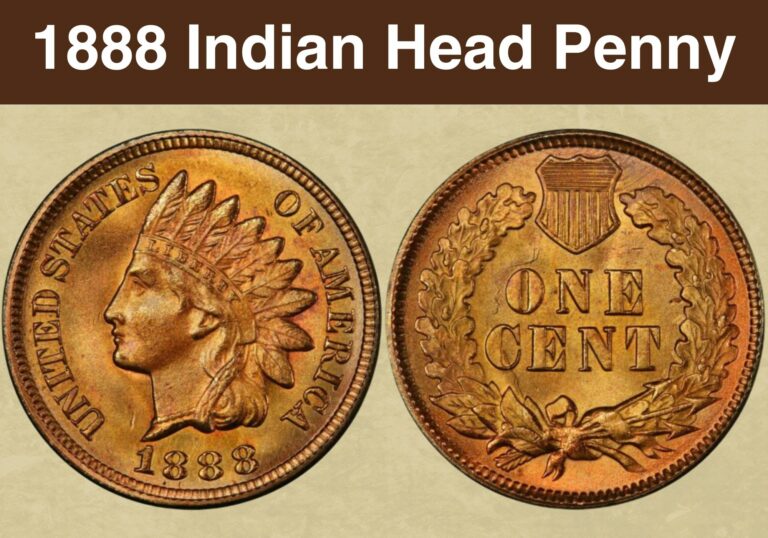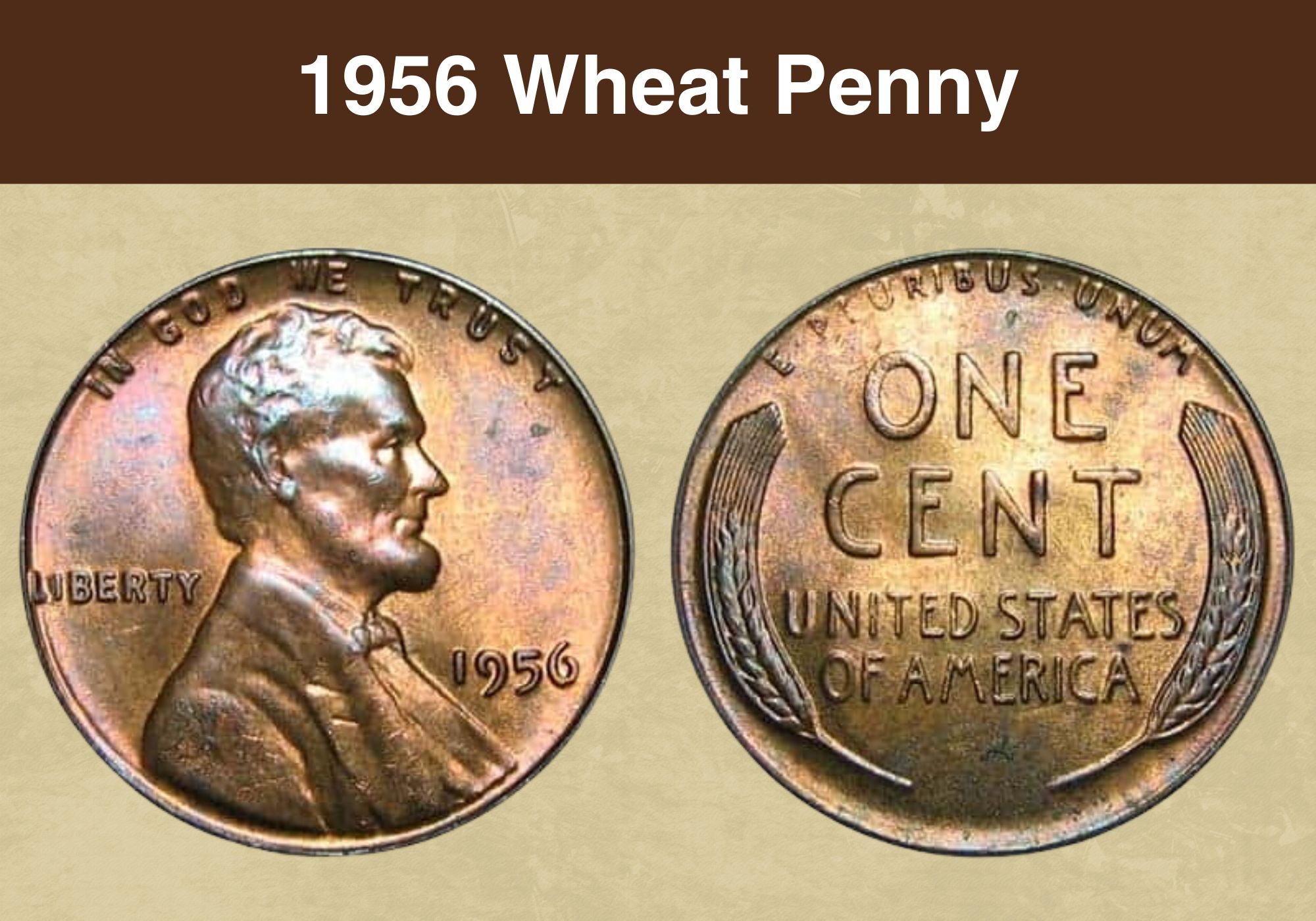
Coin Value Contents Table
The US Mint struck over 1,5 billion pennies (cents) in 1956, making this copper coin abundant and common nowadays. Therefore, you can expect that the 1956 penny value is relatively low, even in the highest grades. Only rare, super-quality red-toning coins in this set are worth more than a few bucks.
You can recognize three 1956 cent varieties, two regular cents from Denver and Philadelphia, and proof pieces. Since some of these coins are still in circulation, you can add one to your collection if low-graded coins are your passion. Otherwise, setting aside 5 to 10 cents to buy one in the mint state is necessary.
1956 penny value Chart |
|||
| Condition | 1956 No Mint Mark penny | 1956 D penny | 1956 D penny
D above shadow D |
| Good | / | / | $3.38 |
| Very Good | / | / | $5.84 |
| Fine | $0.06 | $0.06 | $8.07 |
| Very fine | $0.11 | $0.11 | $11 |
| Extra fine | $0.14 | $0.14 | $28 |
| AU | $0.17 | $0.17 | $35 |
| MS 60 | $0.40 | $0.34 | $40 |
| MS 63 | $1.16 | $1.16 | $85 |
| PR 63 | $6.81 | / | / |
History of the 1956 Penny
The 1956 Wheat cent mintage began in 1909 when the US Mint officials decided to commemorate the 100th Lincoln’s birthday. Victor David Brenner designed the first American coin with a genuine person on the obverse. The penny reverse showed two wheat stalks, symbolizing the agricultural heritage of the new nation.
1956 penny Types |
||
| Location | Year | Minted |
| Philadelphia | 1956 no mint mark penny | 420,745,000 |
| Philadelphia | 1956 proof penny | 669,384 |
| Denver | 1956 D penny | 1,098,201,100 |
| Total | / | 1,519,615,484 |
Half a century later, the US Mint changed the penny reverse, celebrating the 16th President’s 150 birth anniversary. That makes coins minted in 1956 one of the last before Frank Gasparro created those with the Lincoln Memorial on the reverse, replacing wheat stalks.
Also read: 12 Most Valuable Lincoln Penny Worth Money
Features of the 1956 Penny
Designer Victor D. Brenner created the first so-called Wheat pennies minted from 1909 to 1959. The 1956 Lincoln coins are in a group of the newest with this old reverse design, but they are still collectible.
The obverse of the 1956 penny
This coin is well-known after two names. The first one, the Lincoln penny, came because the image of the 16th President is on the coin obverse. However, you can often hear collectors talking about Wheat pennies. That unofficial name came from two stalks of wheat on the coin reverse.
Lincoln was an American President from 1861 to 1865, and he did crucial things for the new nation before his horrible assassination. One way for a grateful nation to repay him is by choosing this honorable gentleman as the first real person to appear on an American coin.
The reverse of the 1956 penny
As mentioned, you can see two stalks of wheat on this penny reverse. Besides, there are required face value, the name of the country, and a symbolic Latin motto describing the unity of different states on the North American continent.
1956 penny Details |
|
| Face value | One cent ($0.01) |
| Coin weight | 0.10970 ounces (3.11 g) |
| Compound | 95% copper coin with admixtures of zinc or tin |
| Coin thickness | 0.06” (1,52 mm) |
| Shape | Round |
| Coin diameter | 0.75” (19.05 mm) |
| Edge | Plain |
Other features of the 1956 penny
The 1956 penny is a copper coin with admixtures of zinc or tin. It is thick 0.06 inches (1,52 mm), weighs 0.10970 ounces (3.11 g), and has a diameter of 1.75 inches (19.05 mm).
Also read: 13 Most Valuable Wheat Penny Worth Money
1956 Penny Grading
The crucial thing when evaluating your 1956 penny is to determine its condition. The scale includes collectible coins ranking as GOOD for heavily-worn cents to MS reserved for excellently preserved pieces. In this case, you should also check each penny’s color, including red, brown, and red-brown.
| # | Grade |
|---|---|
| 1 | Basal State-1 |
| 2 | Fair |
| 3 | Very Fair |
| 4, 5, 6 | Good |
| 7, 8, 10 | Very Good |
| 12, 15 | Fine |
| 20, 30 | Very Fine |
| 40 | Extremely Fine |
| 50 | About Uncirculated |
| 60 | Mint State |
| 65 | Mint State |
| 70 | Mint State |
Please check our grading guides to know your coin scale, It’s the necessary step to know the exact value of your coin.
Check out now: How to Grade Lincoln Wheat Penny?
1956 Penny Value Guides
The US Mint produced 1,519,615,484 pennies in 1956 in two mints. The Denver mint minted 2.5 times as many regular coins as the Philadelphia mint, but only the second one made proofs.
1956 no mint mark Penny Value
The Philadelphia mint had a high penny mintage in 1956, precisely 420,745,000 coins without the mint mark. The copper content dictates their color, differentiating pieces with various shades into three groups.
Expectedly, their value is also different, so you should pay the lowest price for brown cents, while red ones are the most expensive. All available pennies minted this year are graded from MS 63 to MS 67.
The average price range for brown-colored coins is $0.25 to $45, while the most expensive piece was paid $1,610 in 2004. Red-brown cents are estimated to be $0.35 to $55, depending on grade, while the auction record for this coin type is $820.
Many collectors prefer red Wheat cents and agree that a price range of $0.55 to $900 is appropriate. One dedicated admirer blew the competition away at the auction in 2022 when they set aside $57,600 for one beautiful and rare 1956 penny in MS 67+ grade.
1956 penny (proof) Value
Besides regular pennies, the Philadelphia mint issued 669,384 proofs exclusively intended for collectors in 1956. You can recognize the following:
- 1956 brown pennies that cost $0.60 to $18 (PR 60 to PR 67 grade)
- 1956 red-brown pennies that cost $0.75 to $24 (PR 60 to PR 67 grade)
- 1956 red pennies that cost $1 to $40 (PR 60 to PR 67 grade)
However, you can find red Lincoln cents in higher grades and expect them to be costlier. For instance, PR 68-ranked pennies cost $65 to $85.
On the other hand, those in the highest PR 69 rank are assessed to be approximately $250 to $300. Despite expert estimation, one of these coins changed owner for an impressive $4,995 in 2022.
Dedicated collectors with a higher budget often look for red pieces with cameo contrast. Their estimated value is $15 (PR 65) to $750 (PR 69). As expected, the most valuable is DCAM cents which cost about:
- $125 to $150 (PR 64)
- $200 to $240 (PR 65)
- $300 to $345 (PR 66)
- $600 to $690 (PR 67)
Experts assess PR 68-graded pennies with deep cameo contrast to be $3,800. However, the most expensive coin was sold at $16,100 in 2003.
1956 D penny Value
In 1956, the Denver mint had more than double higher mintage than Philadelphia, 1,098,201,100 cents. The most affordable are those in brown color that cost about $0.25 to $45.
Red-brown-toned coins are worth $0.35 to $55, depending on grade, while the most valuable are red Lincoln cents. You need to set aside $0.55 to $26 for most pieces, but those ranking MS 67 are assessed to be $200 to $300.
While record prices for most cents minted in 1956 are under $1,000, one coin stood out from the crowd. The 1956 MS 67+ red penny with the D mint mark got a new owner for $18,000 in 2022.
Also read: 17 Most Valuable Indian Head Penny Worth Money
Rare 1956 Penny Errors List
Besides standard errors typical for Lincoln cents, the 1956 pennies appeared with a few unique imperfections. As expected, they are more valuable than standard coins and highly collectible. The prices depend on error visibility and size.
Re-punched mint mark
A re-punched mint mark is an error that results from double mint mark striking. Reasons for such an imperfection are numerous, but it often occurs after misaligning the second punch.
The 1956 D/D pennies typically cost $15 to $370, with increased prices for red-toning specimens. However, some coins can be pricey and reach over $1,000 at auctions.
The D mint mark above shadow D
This penny has the standard D mint mark but is placed above the shadow of the D mint mark. It is an RPM error variety and typically costs about $100.
DDO/DDR
This minting error is common among pennies despite the US Mint giving its best to remove them before releasing the set into circulation. This error can appear on the coin obverse, reverse, or both sides.
Most such coins cost about $100 to $325, depending on a doubled image part’s size and visibility. The auction records are significantly higher and are $995 for the red DDR penny and $1,187 for the red DDO penny (both in PR 68 grade).
Double denomination error (penny struck on the wrong planchet)
This error occasionally occurred because the US Mint struck numerous coin types in 1956. In this case, pennies were minted on the wrong planchet, including:
- Honduras 1c planchet
- Dime (10c) planchet
- Elliptical planchet
These uncommon coins can be expensive. For instance, collectors are prepared to buy error pennies struck on dime planchets for $1,500 to $1,700. They weighed less than standard Lincoln coins, 0.084657 ounces (2.4 g), and had cut-off inscriptions.
The 1956 penny struck on a Honduras Centavo planchet is lighter, weighing only 0.052911 ounces (1.5 g). It came without the significant part of the outer edge. The most expensive coin with this error was sold at $2,070.
Finally, you can find attractive and rare 1956 pennies minted on an elliptical planchet, resulting in eye-shaped coins. One such piece was sold at $290 in 2021.
Other errors
Besides specific errors, you can find a few imperfections standard for the penny series, such as:
- Clipped planchet with a missing part of the penny’s edge
- Double curved clip with two cut sides
- Die break with a raised line on the penny’s surface resulting from the die crack
- Off-center with a crescent-shaped blank piece on the penny surface resulting from improperly centered coin during minting
- Struck thru error when the penny was struck through a foreign object, between the die and planchet
- Penny obverse struck through capped die when the penny was minted over the non-removed cap
Also read: 11 Most Valuable Wheat Penny Errors
Where to Sell Your 1956 Penny ?
Now that you know the value of your coins, do you know where to sell those coins online easily? Don’t worry, I’ve compiled a list of these sites, including their introduction, pros, and cons.
Check out now: Best Places To Sell Coins Online (Pros & Cons)
FAQ about the 1956 Penny
What sets the 1956 penny apart from the others in the series?
Most 1956 pennies are ordinary coins uninteresting to collectors. However, a few superb pieces and those with rare errors can reach high sums on eBay or at auctions.
Are there particularly valuable 1956 pennies?
- The 1956 MS 67+ penny (red) changed owner for $57,600 at an auction on December 18, 2022
- The 1956 D MS 67+ penny (red) changed owner for $18,000 at an auction on December 18, 2022
- The 1956 PR 68 penny (DCAM) changed owner for $16,100 at an auction on January 8, 2003
- The 1956 PR 69 penny (red) changed owner for $4,995 on eBay on July 23, 2022
- The 1956 PR 68 penny (CAM) changed owner for $1,840 at an auction on January 1, 2006
- The 1956 D MS 67 penny (red, D/D RPM) changed owner for $1,620 at an auction on April 25, 2021
- The 1956 MS 62 penny (brown) changed owner for $1,610 at an auction on March 11, 2004
- The 1956 D MS 67 penny (red, D/D RPM) changed owner for $1,293 at an auction on February 27, 2014
- The 1956 PR 68 penny (red, DDO) changed owner for $1,187 on eBay on January 22, 2023
- The 1956 PR 68 penny (red, DDR) changed owner for $995 on eBay on November 10, 2022
- The 1956 D AU 58 penny (brown) changed owner for $900 at an auction on March 29-2023
- The 1956 D PCGS Genuine penny changed owner for $897 on eBay on October 30, 2020
- The 1956 MS 67 penny (red-brown) changed owner for $820 on eBay on January 22, 2023
- The 1956 D MS 67 penny (red-brown) changed owner for $660 on eBay on January 22, 2023
- The 1956 D MS 65 penny (red, RPM) changed owner for $369 at an auction on May 6, 2012
- The 1956 D MS 65 penny (red, RPM) changed owner for $195 at an auction on October 09, 2022
What is the 1956 penny (No Mint mark) average price?
Besides condition, the 1956 penny prices primarily depend on each piece’s color. Red-toned cents typically cost $0.55 to $900, while red-brown and brown specimens are more affordable. Their value rarely exceeds $55.
Which Lincoln pennies are the highest-paid ever?
- $840,000 for the 1943 D bronze MS 64 brown penny
- $504,000 for the 1943 S bronze MS 63 brown penny
- $408,000 for the 1944 S MS 66 steel penny
- $372,000 for the 1943 MS 62 brown bronze penny
- $336,000 for the 1958 MS 64 red DDO penny

